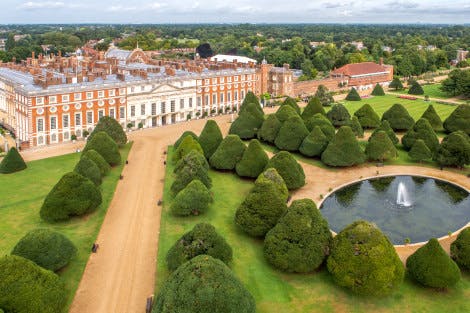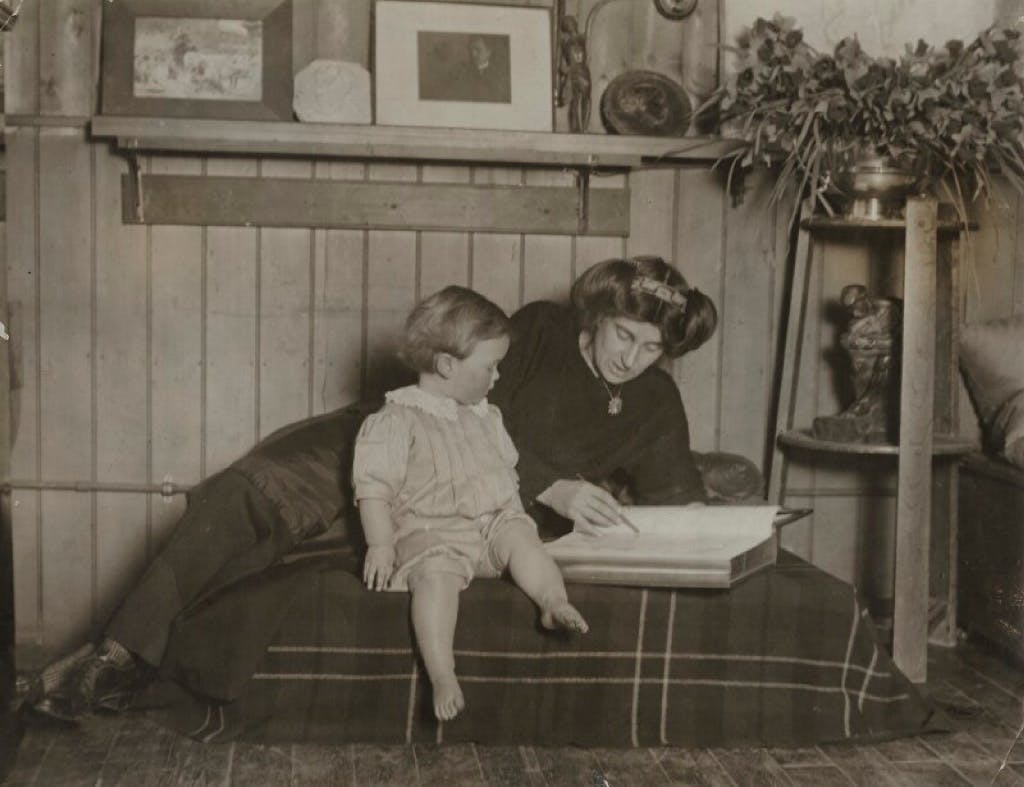The Explorer and the Artist: The Wedding of Captain Scott and Kathleen Bruce at Hampton Court Palace
Date: 04 January 2024
When you imagine a wedding at Hampton Court Palace, a certain Tudor king might come to mind. But our Chapel Royal has hosted many marriages over the years, including the wedding of the famous Antarctic explorer Captain Robert Falcon Scott and sculptor Kathleen Bruce, whose story reaches all the way to the bottom of the world.
Here, Assistant Curator Minette Butler explores how his wedding at Hampton Court intertwines with the aftermath of Scott’s ill-fated expedition to reach the South Pole.
Scott of the Antarctic
Today, Captain Scott is most famous for his tragic death on return from the South Pole, but he was a household name even before he got married. Scott was a celebrated figure in the blossoming Heroic Age of Antarctic Exploration, when the world was gripped by expeditions into the remote, southern polar regions.
Commander of the Discovery Expedition (1901-1904), Scott’s first attempt to reach the pole set a new farthest south record and the expedition unearthed valuable knowledge about the still mysterious continent.
But despite his fame, Scott could be a shy, insecure man. A respected and outwardly charming naval officer, he hid a short temper and deep concerns about keeping up appearances and living up to expectations. After his father died, Scott spent most of his wages supporting his mother.
Image: Robert Falcon Scott c.1905. © National Portrait Gallery, London


The Explorer and the Sculptor
Scott found romance with the artist and socialite Kathleen Bruce. Bohemian and outgoing, Kathleen was one of the few female sculptors of her time. She studied as a pupil of Auguste Rodin and exhibited at the Royal Academy.
Over her lifetime Kathleen’s glittering friends included TE Lawrence (of Arabia), JM Barrie and Prime Minister HH Asquith. Kathleen first met Scott at a lunch party where she told him stories about going 'vagabonding' – long holidays abroad spent walking and sleeping outdoors.
The couple knew they were very different people and debated about getting married. Kathleen wrote later in her autobiography that, 'On two occasions I broke off the [engagement], but [Scott] was so patient – no scolding, no recrimination. "Take your time girl!" was all he said.'
Scott worried about money and that Kathleen might judge him for his carefully hidden anxieties. Meanwhile, Kathleen valued her independence. She also claimed to be looking for a man worthy enough to father her future son.
But ultimately, Kathleen was fond of her 'decent, honest, rock-like naval officer' and Scott took comfort in her artistic, free-spirited nature. They announced their engagement in 1908.
Image: Kathleen c.1920-25. Library of Congress, Prints & Photographs Division, LC-B2- 6031-4
Image (below): Captain Scott and Kathleen on Quail Island in New Zealand, circa 1910. The two men on the left are unidentified. Ref: 1/2-016452-G. Alexander Turnbull Library, Wellington, New Zealand.

Amongst uncertainties, this is certain - I love the open air, the trees, the fields and the seas, the open spaces of life and thought. You are the spirit of all this to me, though we have loved each other in crowded places. I want you to be with me when the sun shines free of fog.
Letter from Scott to Kathleen, dated 26 May 1908
The Scott-Bruce Wedding at Hampton Court Palace
It was through Kathleen's aunt, Zoe Thompson, that Captain Scott and Kathleen came to Hampton Court Palace for their wedding.
Zoe was the widow of the Archbishop of York, and one of many single women granted Grace and Favour apartments at the palace in recognition of a close family member’s service to the country.
The Chapel Royal had performed marriages for families of palace residents since around 1890, and Scott had been best man at a Hampton Court wedding in 1906. The explorer was pleased with the chosen venue, though he wrote apprehensively that it was 'as pleasant a place can be chosen for a trying ceremony'.
On 2 September 1908, the Chapel Royal was decorated with lilies, ferns, and palms for the Scott-Bruce Wedding. The guestlist of more than a hundred people included Grace and Favour residents as well as veterans from Scott’s Discovery expedition.
It was a sunny day, but three thunderclaps interrupted the service – ‘a salute from heaven’, one guest joked. As Kathleen walked down the aisle, the bride spied Scott’s handsome best man, Captain Henry Campbell, waiting at the altar. She playfully teased her groom about marrying his friend instead.
Image: The Chapel Royal at Hampton Court Palace. © Historic Royal Palaces

I remember walking through the cold, dark cloisters holding up my white satin dress, and the joy of seeing [Scott] waiting for me…
Extract from Kathleen's autobiography, remembering her wedding at Hampton Court Palace

Reception in a King's Dining Room
Newspapers reported that the reception was held in the Oak Room – better known today as the King’s Private Dining Room in William III’s apartments.
Built around the late 17th century, the room found new life under Grace and Favour. From the late 1860s, residents used the space as a meeting room, theatre, and dance hall. Scott and Kathleen’s reception was one of many parties hosted here over the years.
Image: The King's Private Dining Room at Hampton Court Palace. © Historic Royal Palaces
'Wildly in Love'
Welcoming their son Peter in 1909, Kathleen had fallen ‘gloriously, passionately, wildly in love’ with her husband. Meanwhile, the explorer confided everything to his strong-willed, adventurous wife – including the plans for his next expedition.
Scott Departs for the South Pole
Kathleen watched Scott depart for Antarctica on 29 November 1910. Leaving him behind on the Terra Nova, she wrote later that, 'I didn’t say goodbye to my man because I didn’t want anyone to see him sad.' She never saw her husband again.
Scott’s final expedition is one of exploration’s most infamous tragedies. Beaten to the South Pole by Norwegian Roald Amundsen, all five members of his Polar Party perished on their slow and brutal trek home through the Antarctic wilderness.
Scott’s last thoughts, written in the diary recovered from his frozen body, seemed to turn to those they left behind. 'For God's sake,' he wrote, 'look after our people.'
You know I have loved you; you know my thoughts must have constantly dwelt on you… the worst aspect of this situation is that I shall not see you again.
From Scott's Last Letter to Kathleen (addressed to "My Widow"), dated March 1912
Grace and Favour
In a twist of fate, Hampton Court Palace helped answer Scott’s hope that 'his people' would be cared for after his untimely death.
In 1913, newspapers reported that Kathleen (now known as Lady Scott) was offered her own suite of Grace and Favour apartments at Hampton Court. If true, she apparently declined.
However, the papers may have confused Kathleen with the other woman in Scott’s life. Sure enough in 1915 his mother, Mrs Hannah Scott, was granted rooms at Hampton Court, where she lived until her death in 1924.
Lady Scott, Lady Kennet
Kathleen returned to Hampton Court a few times after her husband’s death. She visited her mother-in-law's rooms in 1920 and attended a service at the Chapel Royal during the Second World War.
Despite her private grief, Lady Scott stayed strong in the public eye. Defensive of her husband’s legacy, she immortalised his image in her art, including his statue in Waterloo Place, London. A prolific artist behind many famous monuments, Kathleen is recognised as one of Britain’s most significant early female sculptors.
Kathleen eventually married politician Edward Hilton Young, who later became Baron Kennett, and together they had another son, Wayland. She died in 1947, aged 69.
Image: Kathleen in 1934. © National Portrait Gallery, London

This is just one of many stories hidden away at Hampton Court. Our curators and volunteers continue to carry out new research into the fascinating Grace and Favour community and their surprising connections around the world.
Minette Butler
Assistant Curator, Historic Royal Palaces
Antarctic Exploration and Grace and Favour
Listen to the podcast
In the latest episode of the Historic Royal Palaces Podcast, follow Assistant Curator Minette Butler as she explores a shut-off part of the Palace, highlighting how new research into Grace and Favour residents is revealing such curious connections, as well as opening up the lives of the Palace’s most recent residents.
More episodesSuggested Reading
- Anne Fletcher, Widows of the Ice: The Women That Scott’s Antarctic Expedition Left Behind (2022)
- Katherine MacInnes, Snow Widows: Scott’s Fatal Antarctic Expedition by the Women Left Behind (2022)
- Diana Preston, A First-Rate Tragedy: Captain Scott’s Antarctic Expeditions (1997)
- Louisa Young, A Great Task of Happiness: The Life of Kathleen Scott (1995)
More from our blog

A Turkish Bath for Horses at Hampton Court
16 June 2022
With eyes on Royal Ascot in June, we wanted to share a lesser-known aspect of Hampton Court’s Equine Past. In the 1860s a Turkish bath was installed at Hampton Court Palace…for the horses! Buildings Curator Alexandra Stevenson explores this curious history.

The Tragic Story of Lady Katherine Grey
08 November 2022
Chief Curator Tracy Borman takes a look at the life of Katherine Grey, who like her sister, Lady Jane Grey, was imprisoned at the Tower of London.

Sir Christopher Wren's Hampton Court Palace
08 March 2023
Head of Historic Buildings Daniel Jackson looks at one of Sir Christopher Wren's most famous and problematic projects: the remodelling of Hampton Court Palace.

